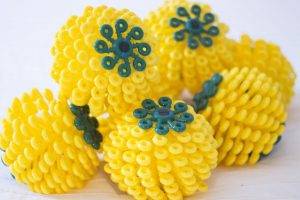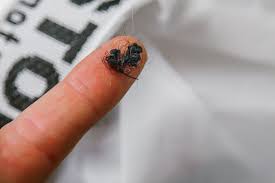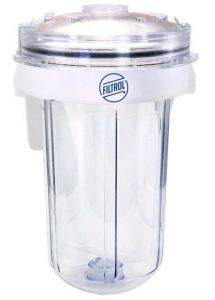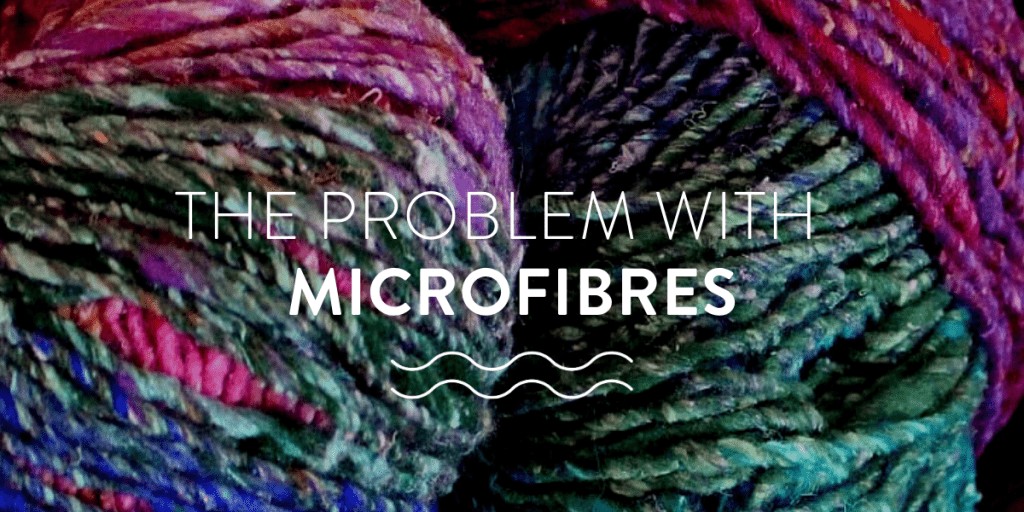Plastic pollution is a bigger problem than just the noticeable items we see every day – straws, single-use utensils, and soda bottles. Microfibres, while small, make up a large part of the problem. Plastic does not biodegrade, but it does degrade. It breaks down into smaller and smaller pieces. Once these pieces reach the threshold of 5mm or smaller, they become known as microplastics and they make up one of the most common types of plastic pollution. Microplastics may be intentionally produced, such as microbeads in face wash (many of which have since been removed from the market), or may be unintentionally produced. These byproduct microplastics are often the result of erosion of plastic products. Synthetic clothing is not exempt from this problem, which leads to the topic of microfibres.
What are microfibres and where do they come from?
Microfibres are small fibers that are shed from items like clothing, sheets and carpets. They can be shed from both natural and synthetic items. Synthetic microfibres, just like other microplastics, have a widespread presence in the ocean. The world consumption of synthetic textiles is estimated to be 43 million tonnes a year and it is estimated that 34.8% of microfibre release into waterways is a result of washing synthetic textiles in the laundry.
So how would recycled plastic clothing be any better than clothing made with new synthetics? Here’s how: plastic has only a limited number of times it can undergo the recycling process. It eventually becomes too brittle to be successfully recycled again. So, say you have a plastic water bottle you recycle. That plastic bottle could become a plastic water bottle a few more times before it ultimately becomes useless pieces of fragile plastic trash. Or it could be sequestered into an item that has a long lifespan. Enter: clothing, furniture, or other goods that are long lasting. Isolating recycled plastic and transforming it into something useful and durable is a great way to remove the materials from the waste stream before reaching the point that it becomes nonfunctional scrap.
Reducing our footprint through laundry
As individuals, we can reduce our personal microfibre footprints through smart washing methods. To keep your laundry as environmentally friendly as possible, there are a few devices on the market made specifically to catch microfibres. We’ve done the research so you don’t have to!
The Cora Ball
What: The Cora Ball is a microfibre-catching device that is literally a ball. It is modelled after observations of coral filtration in the ocean. It is very simple to use with no upkeep. Simply toss the Cora Ball into the washing machine and collect the fibres that it picks up!
Efficacy: Based on independent tests conducted by researchers at the University of Toronto, the Coral Ball reduced microfibres in washing machine effluent by 26%.
Price: $37.99 USD

The Guppyfriend Washing Bag
What: The Guppyfriend Washing Bag is similar to a delicates bag that protects clothing. The mesh size is fine enough that it reduces microfibres escaping into washing machine discharge. Just put your synthetics into the bag during the wash cycle and it will contain any shed microfibres! Remove these when they begin to build up inside the bag.
Efficacy: The Guppyfriend Washing Bag has been tested by the German Textile Research Institute DTNW, Fraunhofer Institute UMSICHT, and the University of California Santa Barbara. The Fraunhofer Institute UMSICHT confirmed that the Guppfriend Bag retained 79% of microfibres from partly synthetic clothes and 86% from completely synthetic clothes. Other tests showed microfibre retention upwards of 90%.
Price: $29.75

The Lint LUV-R
What: The Lint LUV-R is a washing machine discharge filter that removes lint and microplastics from washing machine discharge. It attaches to the washing machine and comes with a five-year guarantee. The clear filter allows you to easily see the amount of fibres collected. You can simply remove them by wiping the screen trap.
Efficacy: Based on independent tests conducted by researchers at the University of Toronto, the Lint-LUV-R reduced microfibres in washing machine effluent by 87%.
Price: $140.00 USD

The Filtrol 160
What: The Filtrol 160 is a reusable in-line washing machine filter. It attaches directly to a washing machine drain hose and removes microfibres and other debris prior to release into wastewater. Once there is buildup in the fibre trap, empty and discard. The filtrol device itself is anticipated to last years, but does involve filter bags that must be replaced every one to two years.
Efficacy: Unfortunately there seem to be no published studies regarding the efficacy of the Filtrol 160, but according to the company, WexCo, the Filtrol will filtre particles down to 1/256 inch or 100 microns.
Price: $139.99 USD

All of these devices can be used to reduce the impact of shedding during your laundry cycle. Specifically, they can help you responsibly wash your Ocean Mimic swimwear!
More tips to green-ify your laundry routine
- Wash less – certain types of clothes don’t need to be washed after every wear! Some of your clothes will actually thank you for it. Machine washing can be rough on clothes, and many will last longer if you wear them a few times between washes.
- Wash on cold – the cold setting uses less energy for the wash cycle. Reduce that carbon footprint!
- Maximize the load – don’t waste the water and energy on a few items of clothing. Wait until you have a full load ready to go and get the most out of your machine!
- Go for a front-loading machine – front loaders use less water and are less abrasive to clothing compared to top loading machines. If you have the option, choose a front loader.
- Hang dry – hanging your clothes to dry saves a lot of energy! Not only does it help the planet, but your utilities bill might just be a bit cheaper.

Alanna Mnich is a PhD student studying marine science at the University of Massachusetts Dartmouth School for Marine Science and Technology. She is a 2017 graduate of the University of Miami Rosenstiel School of Marine and Atmospheric Science, and a former National Oceanic and Atmospheric Administration Researcher. You can find her on Instagram at @greenmarinescientist for topics in science and sustainability.
Sources:
Thevenon et al., 2014
Prata, 2018
Browne et al., 2011
Boucher & Friot, 2017
McIlwraith et al., 2019


